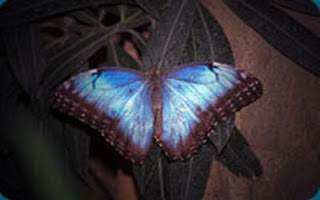
Rappers and butterflies agree on at least one point: when you want to deliver a show-stopping performance, the more bling the better. While rappers have taken a shine to the glitz and glamour of diamonds, some butterflies, birds and beetles have evolved iridescent, luminous colours of their own.
Most of the colours we see in nature are produced by pigments, but a completely different mechanism underlies the shimmering hues of iridescent butterflies. Robert Hooke and Isaac Newton were the first to hypothesise that these creatures possessed miniscule physical structures which manipulated light. Fast forward a few hundred years and researchers are still busy unravelling the mysteries of what is known as structural colour.
Standing out from the crowd
A typical iridescent butterfly’s wings are carpeted in hundreds of thousands of tiny scales. ‘These scales are anything from 1 to 3 microns thick and laid out like roof tiles,’ explains Dr Peter Vukusic, a physicist who studies iridescence in nature at the University of Exeter. Each of these scales is in turn composed of several layers of ultra thin film.
‘When light hits the top surface of the film, some of the wave is reflected, and some is transmitted downwards,’ says Vukusic. The transmitted wave then strikes the lower surface of the film and bounces back up, rejoining the light that was reflected from the top surface (see diagram).
This means that the transmitted wave travels further than the reflected wave and, depending on the thickness of the film, the two waves can become out of phase – the peaks and troughs of the waves no longer line up exactly. Any phase difference causes interference between the two waves.
Vukusic compares the process to ocean waves coming into a harbour. Upon meeting, two coinciding crests can form a ‘super crest’, or a crest and a trough can cancel each other out. Similarly, the butterfly’s scales will amplify certain wavelengths of the reflected light, whilst dampening others, affecting the colour that we ultimately see.
More than just producing unusual shades, structural colours bring added intensity. ‘Pigmentary colour is often not very bright, as incoming light is not reflected in any particular direction’, says Vukusic. Structural colour, on the other hand, directs light, grabbing viewers’ attention with flashes of brilliant colour. Depending on the species, this can serve to attract the opposite sex, intimidate a rival, or ward off predators.
The Butterfly Effect
It may seem that science is finally catching up with nature’s nifty designs, but there is still plenty left to learn. ‘It’s an exciting field to be working in’, says Vukusic. ‘Every single day we are looking at species that have never been investigated before.’
An increased understanding of these systems has already inspired a number of applications, from antifraud devices on banknotes to shimmering eyeshadows. It can only be a matter of time before rappers catch on as well.
www.physics.org![]()
03 October 2008
Setting hearts aflutter
Posted by
Made Sumariani
Labels:
Physics,
Setting hearts aflutter
Subscribe to:
Post Comments (Atom)











No comments:
Post a Comment